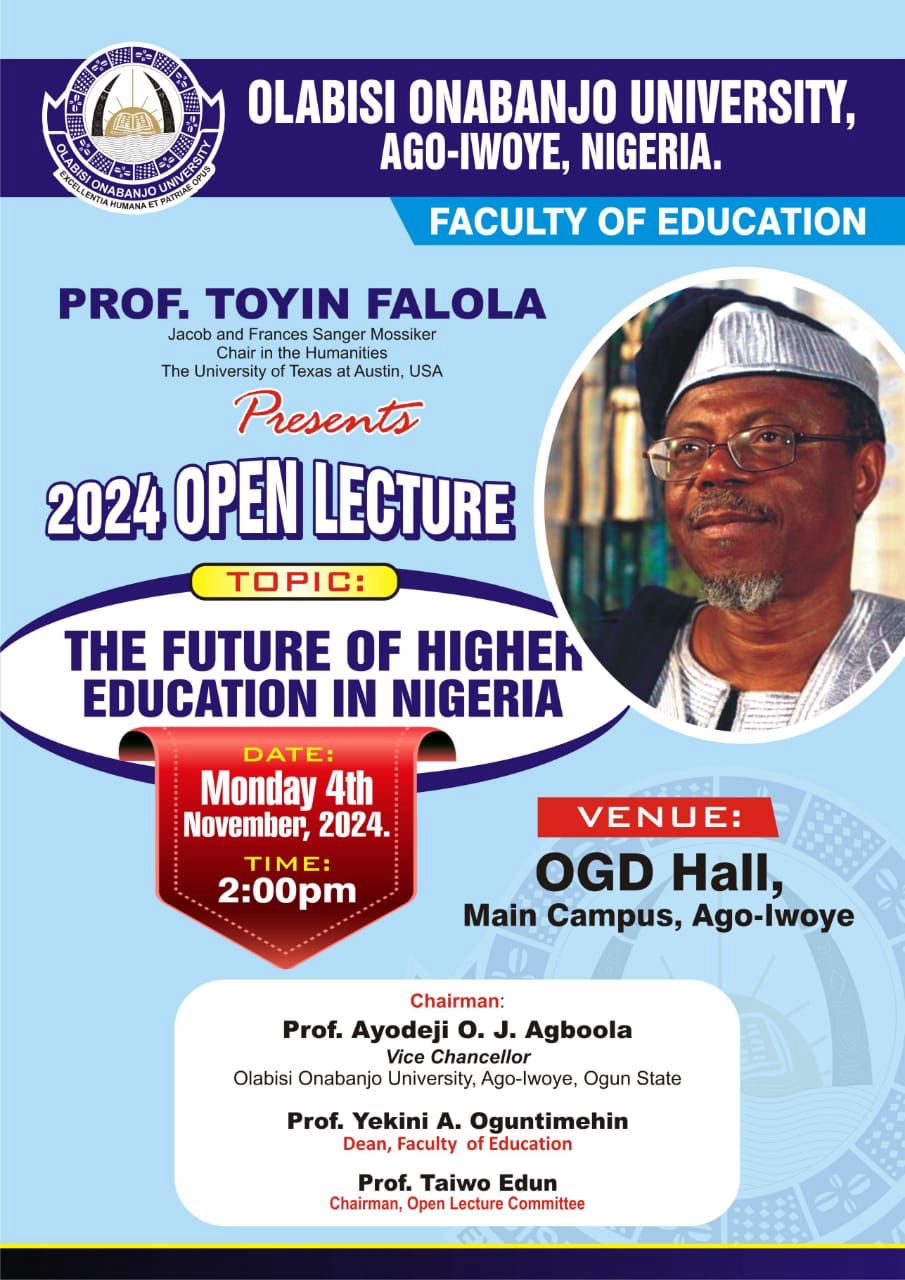By Toyin Falola
On November 4, 2024, I will address the faculty and students of Olabisi Onabanjo University, Ago Iwoye, Ogun State, Nigeria, on the future of higher education. My gratitude goes to Professor Biodun Ogunyemi, who facilitated the invitation. Last May, we assembled a competent and courageous team of educators in Kenya to offer cogent guidelines on this important topic needed to transform Africa. At Olabisi Onabanjo University, I will continue with this conversation. In this pre-lecture release, I take the conversation to one of the preeminent stakeholders: the parents, politicians, and administrators.
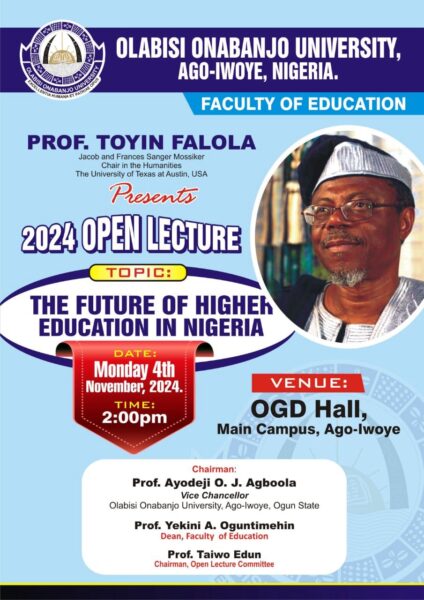
A few weeks ago in Nigeria, a video emerged of an X user, identified as Bello Galadanchi, who refurbished a classroom in Northern Nigeria with 4.1 million naira. Before then, he had been preceded by popular philanthropist and content creator, Asherkine, who has accomplished a similar feat deep in the mountainous regions of Plateau State. The same period has witnessed a school closure at Nigeria’s premier tertiary institution, the University of Ibadan, following protests over fee hikes by the students. All these point to one thing—the education system is in serious peril. And it is not just in Nigeria. Research suggests that sixty per cent of children aged 15 to 17 are not enrolled in school in Africa, with only nine per cent enrolment level in higher education compared to the global average of forty-two per cent.
The United Nations also states that around forty to fifty per cent of graduates are unable to find employment, resulting in a mismatch between the job market and available workforce. This spells bleak prospects for the continent as the bulk of its population are young people. Other nuanced challenges exist in the form of underwhelming levels of girl child enrolment in schools, funding for tertiary institutions, and investment in research by national governments, among others. I discuss these challenges in the following section, with a view to submitting approaches to reforming higher education in Africa. The focus areas will be curriculum quality, access and equity, funding, and governance.
Another major challenge that higher education in Africa faces is the quality of the curriculum. Many African universities do not offer the ‘best’ education, not because of only the shortage of infrastructures and resources or the absence of qualified workers but because of the quality of our curricula. The graduates are generally not employable, and hence, the skills in the nation’s workforce are low. Furthermore, the curricula of only a few African universities are simply not in tune with the job market demand, thereby making the skills of graduates irrelevant. The curriculum is the blueprint of a formal institution; scholars consider it vital to the development of the ‘best’ student who is ready and fully equipped to make meaningful contributions to society.
This largely differentiates the formal education system from informal education as the latter is more inclined to follow a less systematic pattern with a limited focus on timelines and core learning objectives. The demarcated nature of curricula makes them fundamentally predictive frameworks that signpost the growth and development of individual students at diverse stages. What this implies is that a close study of the guides for building learners should typically supply crucial insights into the level of exposure they have obtained and the expectations that the outside world, or employers, more specifically, may expect from them. However, the African case presents a puzzling situation as the existence of curricula with the appearance of innovativeness does not immediately indicate high-quality instruction—that is, even when such curricula are present in the first place. Foundational to the development of learning frameworks in the African educational psyche are the inputs of colonialists in the design and structure of scholarly training.
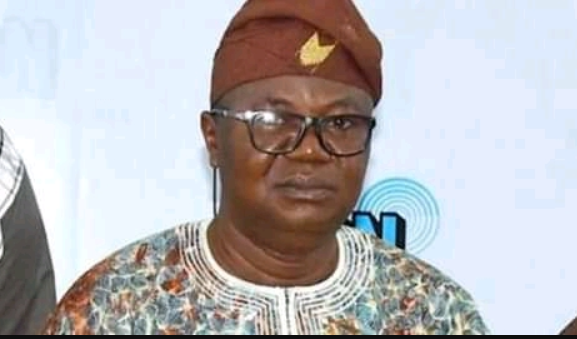
The implication of this is that the more immediate interests of colonisers were prioritised over any benefits an education system should naturally repose in its absorbers. Africans were better equipped for clerical functionalities than the intricacies of self-government, such as economic planning, nation-building as informed by pluralistic sociological contexts, and road mapping technological advancements for international competitiveness. This integration of intellectual subservience into the educational architecture meant that African countries such as South Africa and Nigeria had to react by outrightly seeking to overhaul their curricula in protests against their overlords’ self-interests. In South Africa, this took the shape of a recalibration of the education provided to the black majority, given its failure to comprehend the diversities and nuances existent in the country’s social fabric. In Nigeria, the curriculum overhaul focused on ascertaining preferred learning outcomes on a context-by-context basis. Some of the evident changes were the introduction of new subjects, such as the study of Geography, French, and History, among others. Notwithstanding, while the people responsible for the design of colonialist curricula in the first instance have progressed from their decades-old templates, echoes of the historical heritage remain today. Researchers have argued variously for a need to decolonise African education curricula to tackle the burdens of a fast-paced, technologically driven world.
Moreover, the challenges of modern Africa have been submitted as demanding an Africanised, local approach to achieving resolution. I have chosen to intersect seamlessly with these debates through work to establish interest in a field known as African Ancestral Studies. The mentality behind my efforts and those of other scholars invested in this derives from assessments that uncover the unconscious impacts of Westernised models of thought on the minds of the colonised. This reflects itself in the problem-solving techniques adopted by leaders and followers who, despite existing in a unique cultural environment, still import fixes to native problems. Aside from indoctrination into the mores of the oppressor, language has proven to be one very important way of reorganising the thought-forming patterns of a person’s mind. Language dictates the attitude of individuals towards the world, other people, and their ecosystem at large. It outlines standards of engagement based on set societal principles. Thus, a student trained exclusively in using British forms of address may find ‘sir’ and other aspects of the politeness lexicon a way to interact with elders and superiors. On the other hand, more symbolic gestures or physical movements are considered more culturally appropriate and suitable for other persons whose adaptation to their society has either been entirely informed by traditional instruction or constitutes a predominant aspect of it.
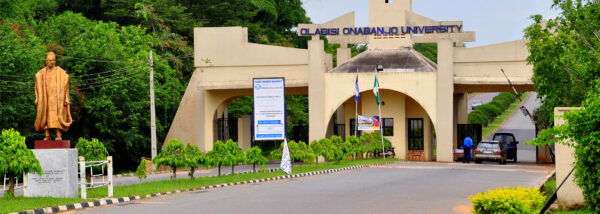
A concise explanation of the role of indigenisation or culturally competent education lies in the Arab world, where the more liberal of the Western world are compelled to conduct themselves in keeping with the expectations of society. There, the norms of speech, conflict resolution, kinship, romantic relationships, nation-building, businesses, and governance are born out of the injunctions of religious texts and practices evolved and inculcated through centuries of historical progression. Arguably, this has worked out well for them. The African curriculum differs in that it is resistant to practical, realistic change and persists in channelling the impulses of its colonial ideators. This manifests itself in focus on instructions in the theoretical ambits of course contents without pragmatic applications of these skills. In Nigeria, for example, the phrases la-cram and la-pour are very popular in the vocabulary of Nigerian tertiary students, one that is quite interesting and also learned as far back as their secondary school days. This is because of the educators’ emphasis on the rigid assimilation of taught subjects with extremely tight manoeuvring space for creativity and critical reflection. If anything, students who venture to think outside predetermined boxes are punished rather than rewarded by their instructors who, likely due to a sense of insecurity or conservativeness, cannot contrive novel, radical approaches to doing things. This teaching method is also evident in students’ delivery of academic projects where they are typically not encouraged to explore fresh perspectives in research. The contrast with teaching techniques in the Western world is noticeable as new African entrants to European or American classrooms will find themselves faced with instructors who encourage conversation and two-way criticism of academic content. This structure spurs the students’ interest in their course and inherently fosters a culture of debate that impacts society in the long run.
Through this analysis, we come to realise that not only do African scholars and teachers need a break from tendencies absorbed in the decades of colonialism, but they possess fairly equivalent faults, too. While I do not diminish the impact of colonial training, the cadre responsible for training students themselves tend to be detractors of new thinking. This is simply a situation of old wine filled into a new skin—the quality of the product remains the same. In environments where lecturers continue to utilise the same tried and tested methods for developing students, even if they are on new subjects, it is seriously doubtful that the perceptions of the students will transform so radically towards their classroom. For instance, if a new discourse were introduced on the subject matter of feminism, the body language, speech and mannerisms of the learning managers may still project misogyny, thereby doing little to impact the students beyond emphasising readiness for examinations.
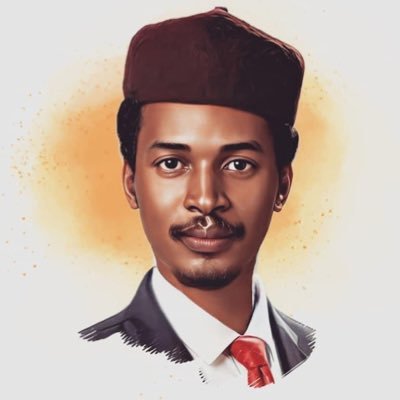
Lack of quality training and reorientation for the trainers may also affect their attitudes to the subjects they are charged to teach. In the absence of these elements and performance metrics, continuous rewrites of curricula will not change the status quo. Nevertheless, I do not excuse the impetus for revolutionising our academic standards to embody an indigenous outlook. There is a highly palpable erosion of values and familiarity with what is truly African in the present day. Across cities and rural environments, everything from architecture to fashion, speech and ideology are primarily imported from far across the Atlantic. To restore the importance of the African psyche, universities are exceedingly important places for kickstarting this movement.
Moving on, access to higher education in Africa remains limited, particularly for marginalised groups such as women, rural dwellers, and people with disabilities. Financial constraints, geographical barriers, and cultural norms can prevent many individuals from pursuing higher education. According to data from the United Nations, only four out of every one hundred African children are expected to pursue a graduate or post-graduate education compared to thirty-six in Latin America and fourteen in South and West Asia. The driving factors are intricate, as while students face inequities in financial constraints, geographical and social reasons also challenge them. In effect, students who reside in distant, hard-to-reach locations may not only be barred from obtaining a higher education but may also be prevented from schooling up to the secondary school level in the first instance. The effect is that only a fraction of students who are age-qualified for secondary school are enrolled, and an even smaller number in tertiary institutions. Equity is also strained along gender lines due to long-held views of girl-child education in some of the more conservative regions of the continent.
There are perceptions that it is more strategic for female children to be committed to fetching income from early marriages for their low-income families than being sent to school where costs will be incurred for their fees. An additional barrier to girl-child education is that in cases where female children are educated, they are forced to deal with the difficulties of period poverty in schools that are frequently ill-equipped to handle it and families that are either too poor or under-educated to minimise their burden. The challenge with access extends to people living with disabilities who are doubly faced with the costs of care and disability-friendly infrastructure in higher institutions. Though laws exist to mitigate these issues in countries such as Nigeria, they have yet to transform into phenomenal change at the scale necessary to remove barriers. Worse still, poverty continues to be a major determiner of the academic outcomes of African students, with data revealing that a high of fifty-four percent of sub-Saharan Africans are very concerned about paying school fees. In countries such as Kenya and Nigeria, school fees are frequently documented as a major financial worry, with sixty percent of adults attesting to this fact in Uganda.

This is quite expected due to the high burdens of poverty in many African countries. Though programmes have been implemented to guarantee access to education for children, ancillary expenses such as transport costs, uniforms, and stationery, among multiple other hidden costs, prohibit an uptick in education levels. It is, therefore, not farfetched to reason that the same problems inhibiting educational access at elementary levels would substantially prune the population of students trickling into the higher education system. Previously, students across Africa have protested the high costs of education. South Africa was a major protest that spread across universities in the country in response to a 10.5% increment in expenses. This was despite a perceived lack of corresponding increase in the quality of education delivery. In Nigeria, similar protests have been a theme of the higher education experience, resulting in school shutdowns in different institutions. The most recent effort by the government to finally pass on the costs of schooling to the population has seen nearly a hundred billion naira disbursed in loans under a scheme known as the Nigerian Education Loan Fund. It is not unusual to find sentiments portraying education as a public good among ordinary people. I do not believe they are incorrect, given the decades of economic deprivation and injustice that pervades many African countries. In the same vein, however, this limited access to higher education can perpetuate the very social and economic inequalities that complicate it, putting the continent on a problematic trajectory.
In a report, it was stated that the African Union failed to meet its Agenda 2063 targets on all accounts. This is despite the obvious benefit of forty-seven million fewer poor people by 2043 and a 368-billion dollar addition to its Gross Domestic Product. The problem may itself be inextricable from funding as many African universities rely heavily on tuition fees to stay afloat. This is not a condition unique to Africa, as similar challenges occur in the West. The catch, however, is the inability of parents and guardians to meet this demand. Aside from shutting out lower-income households, compensation by decreasing the quality of education is a reliable fallback mechanism that universities may use in competing for students. Without government assistance to cushion the strain of maintaining infrastructural and staff quality, the natural consequences are unimpressive research and scholarly products. To make matters worse, laxity in governance stunts the development of African higher education. As expected, weak governance and accountability can lead to corruption, inefficiency, and a lack of transparency in any institution, the impact of which is the depletion of trust by staff and other patrons.
The Importance of Reforming Higher Education in Africa
Higher education underpins economic growth, social development, and global competitiveness. In Africa, where faster urbanisation, technological change and globalisation present major challenges, higher education is essential. A strong higher education sector can promote innovation and entrepreneurship and equip students with the skills and capacities that drive economic growth. The World Bank shows that countries with higher levels of education tend to have higher per capita GDP. Because most countries in Africa – where a third of the world’s extremely poor live and struggling to transcend the demands of raw commodity dependency – are facing the imperious task of economic diversification and income increase to pull more of their people out of poverty, investment in higher education is one of the main strategic objectives. Higher education can contribute to social development, too. Access to higher education can reduce poverty, improve health outcomes and contribute to more socially just societies. Education can empower people to break out of the cycle of poverty and improve their livelihoods. Education has been linked to improved health, including reduced mortality and improved access to health services. Higher education can also promote social cohesion and tolerance by teaching students the value of intercultural exchange and critical thinking.
The quest for global competitiveness represents another compelling rationale, placing pressure on top governments to instigate meaningful reforms in higher education. Any country that wants to attract human talent, investments or markets in today’s globalising world must be able to create an enabling environment to facilitate competitive human potential. The rationale behind the argument is that the higher education sector serves as a tool for producing talent and human capital that will be competitive in the global arena. According to the African Development Bank, the evidence shows that school leavers in Africa lack the required talents to cope with a 21st-century work environment. Factors attributed to this crisis include a lack of emphasis on technical and vocational education, a lack of emphasis on soft skills development, a lack of science, technology, engineering and mathematics (STEM) education, and a lack of entrepreneurship curricula. There is no doubt that higher education spurs innovation and entrepreneurship, both of which are vital to the creation of new industries that stimulate economic growth.
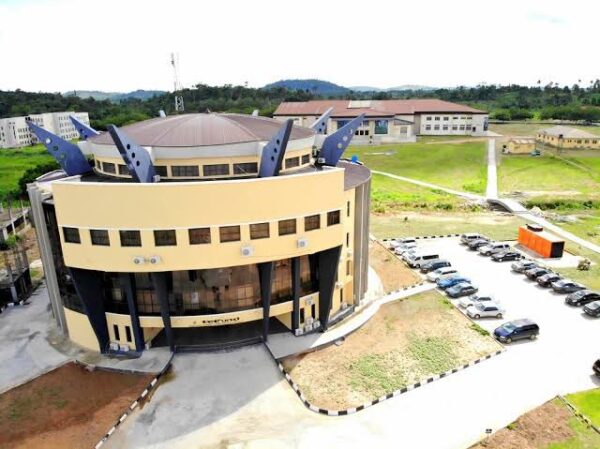
The change would include the establishment of a system of quality assurance frameworks and standards to ensure that universities deliver a quality education that promotes graduates who are innovative, creative, critical and pragmatic thinking problem solvers and citizens who can contribute to their respective economies; widening access of higher education to more disadvantaged groups through scholarships, bursaries and affirmative action policies; increased budget allocations to government institutions of higher education and accessing alternative sources of funding such as endowments and businesses partnerships; strengthening institutions of higher education governance and accountability to ensure fiscal discipline and transparency; and fostering south-south and co-operation between universities in Africa and those in the global north to promote the exchange of ideas and expertise and strengthen institutions. In this way, countries in Africa could repurpose their institutions to be agents of economic growth, social transformation and global competitiveness. This would be a major undertaking, not to be viewed lightly. Reforming higher education is a complex, multifaceted, and sustained effort that demands the collective contribution of government, universities, and other stakeholders.
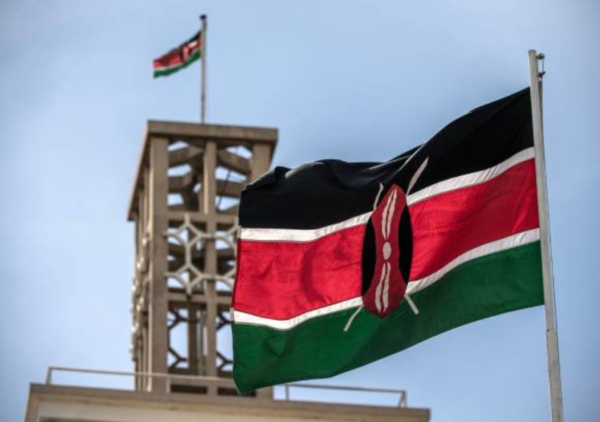
Notwithstanding, Africa has its examples of success stories in higher education reform, suggesting that the idea of success is not futile after all. The first notable example is South Africa’s higher education reform agenda. South Africa has successfully implemented a series of reforms that have targeted improved access to equitable and quality higher education. These reforms include the formation of two major policies: the National Student Financial Aid Scheme (NSFAS) and the National Qualifications Framework (NQF). The NSFAS was adopted by the South African Government in 1992 after an intense debate in post-Apartheid South Africa about how to improve access to education for the poor, previously excluded black majority from higher learning institutions. Through the NSFAS reforms, the government introduced scholarships and bursaries to support underprivileged students in their quest to pursue tertiary education. Bursaries are targeted to assist students with extraordinary financial handicaps, while scholarships focus on economically challenged students. One consequence of this policy is that South Africa has been able to sustain a mounting increase in the number of students in higher learning institutions. The NQF was aimed at building on and entrenching learning experience into a unified framework for all employees, employers and the education-policy-making arm of the government.
Kenya has also followed this path in its way, through what could be described as a local variant of the ‘glocal’ model – which gives us the era of policies such as expanding access to higher education through the opening of new public universities: since the 2000s, government and private universities have grown by fifty-two percent; its Commission on University Education, established in 2012, is in charge of accreditation and quality assurance of its universities. Most simply, the opportunities for building new academic structures should be seized, considering the needs of the local environment and the continent. All these changes deserve constant monitoring and re-evaluation.
